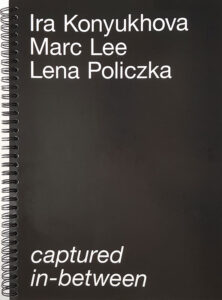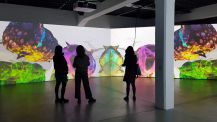Captured in-between Dys-Utopia, Katalog

Captured in-between Dys-Utopia
Kunstverein, Friedrichshafen, GermanyCataloge, color, 90 pages, 21 x 30 cm
2021
English, German
Hannah Eckstein
kunstverein-friedrichshafen.de, PDF (page 38-63)
The catalogue includes a detailed documentation of the exhibition, a foreword by the curator, Hannah Eckstein, and texts by Ulrike Bergermann, John Brennan and Heiderose Langer on the works of the participating artists Ira Konyukhova, Marc Lee and Lena Polizcka.
Utopias as well as dystopias are profoundly human concepts. The first utopia can be traced back to antiquity and Plato’s Politeia, in which the notion of an ideal society was recorded for the first time in human histo-ry. The term ‘utopia’ itself was coined in 1516 by the English statesman and humanist Thomas More in his novel On the Best State of a Republic and the Island of Utopia. The title already suggests that this work shares as its theme an ideal society in an ideal state. Evidently, both Plato’s and More’s works arose from a humanistic way of thinking that believes in a better form of existence for mankind.
The counterpart of utopia, dystopia, arose in the industrial age, when towards the end of the 19th century the long established belief in the in-evitability of progress - especially fuelled by the rapidly developing tech-nical possibilities – was shaken. Scientific and technological achieve-ments made profound changes to people’s everyday existence, altering their perceptions of an ideal life. Previously utopian ideas had sudden-ly become reality, expanding earlier conceptions of what was humanly possible. But fractures emerged in these utopian ideals: Negative vi-sions of the future, of a mechanized society in which humanity, robbed of its freedom and dignity, lived in totalitarian systems dominated by machines, occurred.
Kuratiert von: Hannah Eckstein
Künstler*innen: Ira Konyukhova, Marc Lee and Lena Polizcka
Deutsch:
Der Katalog umfasst eine detaillierte Dokumentation der Ausstellung, ein Vorwort der Kuratorin, Hannah Eckstein, sowie Texte von Ulrike Bergermann, John Brennan und Heiderose Langer zu den Werken der partizipierenden Künstler*innen Ira Konyukhova, Marc Lee und Lena Polizcka.
Utopien wie auch Dystopien sind zutiefst menschliche Konzepte. Die erste ‚Utopie‘ lässt sich bis in die Antike zurückverfolgen. In Platons „Po-liteia“ wird die Idee einer Idealgesellschaft das erste Mal in der Mensch-heitsgeschichte schriftlich festgehalten. Den Begriff ‚Utopie‘ prägt 1516 der englische Staatsmann und Humanist Thomas Morus in seinem Ro-man Vom besten Zustand des Staates und der Insel Utopia. Der Titel lässt bereits vermuten, dass auch dieses Werk eine ideale Gesellschaft in einem idealen Staat zum Thema hat. Beide Schriften sind folglich aus einem humanistischen Denken entstanden, dass an eine bessere Exis-tenzform der Menschheit glaubt.
Das Gegenstück zur Utopie, die Dystopie, entsteht erst mit dem Zeit-alter der Industrialisierung. Gegen Ende des 19. Jahrhunderts wird der für lange Zeit anhaltende Fortschrittsglaube – insbesondere befeuert durch die sich rasant weiterentwickelnden technischen Möglichkeiten – erschüttert. Die naturwissenschaftlichen und technischen Errungen-schaften bedeuten tiefe Einschnitte in die Realität der Menschen und verändern deren Wahrnehmung gravierend. Utopische Ideen werden plötzlich Realität und die Vorstellung von dem, was menschenmöglich ist zerbricht. Die Menschen werden von ihren eigenen Realitätsentwürfen eingeholt: Negative Zukunftsvisionen einer technisierten Gesellschaft entstehen, in der die Menschheit, ihrer Freiheit und Würde beraubt, von Maschinen beherrscht in totalitären Systemen lebt.
Ausgestellt
10.000 Moving Cities - Same but Different, AR (Augmented Reality)
Mobile App, AR Multiplayer Game
ISEA, Gwangju

Lodhi Art District, Delhi

College of Arts, Chandigarh
Me, Myself & I
Mobile App als Interface für interaktive Kunst-Installationen
Synthesis Gallery, Berlin

Annka Kultys Gallery, London

Synthesis Gallery, Berlin
Friends
Mobile App als Interface für netzbasierte Kunst-Installationen
PRE livepool, Hangzhou

Screenshot, Mobile App

HEK, Basel
Time to Nest Time to Migrate
Mobile App als Interface für interaktive Kunst-Installationen
Reithalle, St. Moritz

HEK, Basel

MoCAUP, Shenzhen